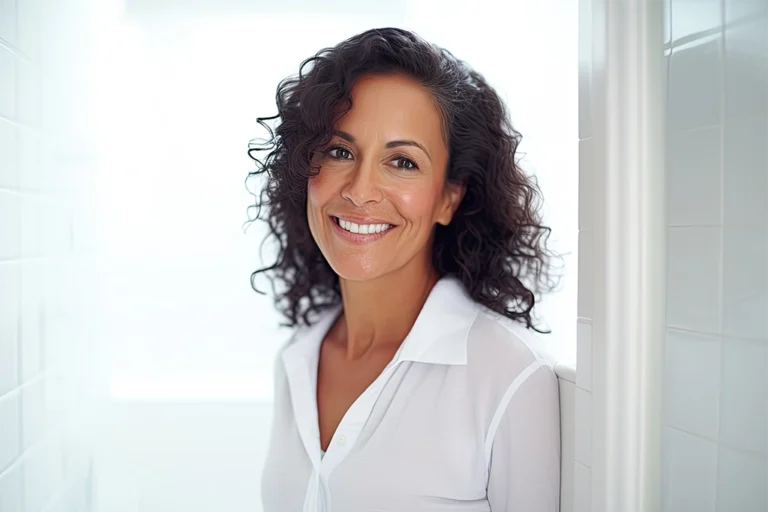Getting your first mammogram is daunting. There are a lot of unknowns, horror stories, and myths surrounding this procedure, yet it is necessary for your health and well-being. Doctors recommend women start getting an annual mammogram between ages 35 and 40, continuing until their 70s. The American Society of Breast Surgeons recommends a 3D mammogram (digital breast tomosynthesis) as your annual scan.
A 3D mammogram provides your doctor with more information than a 2D mammogram. A 3D mammogram results in 2D images of the breasts and a 3D model of the interior breast, allowing for better visualization of the size and borders of abnormalities. Because of this increased detail, a 3D mammogram can sometimes eliminate the need for future imaging. Suppose your doctor does see something abnormal on your 3D mammogram results, though. In that case, they may recommend an ultrasound, which is more detailed, but more expensive (not a scan you want to get unnecessarily).
If you’re nervous about your 3D mammogram – whether you’ve had other mammograms before or not – that is perfectly understandable. Most people are. Here are some good practices to help with your nerves:
- Try to remember that your mammogram is one part of your healthcare routine – just like a checkup or dental cleaning
- Talk to your loved ones about your concerns (maybe even get a friend to book a mammogram at the same time as you, so you can hold each other accountable)
- Keep in mind that it is very rare to get called back after your mammogram, and also that it is even rarer for that callback to result in a cancer diagnosis
- Ask questions – the more informed you are, the fewer potential issues can concern you
- If you’re worried about pain, take ibuprofen or Advil ahead of your appointment
- Tell your radiologist and technician that you’re nervous – they’ll look out for you and do their best to relieve any discomfort
- Treat yourself to a reward after your appointment whether it’s getting your nails done or a coffee on your way home
- Get your scan done at a well-regarded women’s imaging center – like South Jersey Radiology
How Do I Prepare For A 3D Mammogram?
Now that you know how to mentally prepare for your first 3D mammogram, let’s talk about how to prepare your body. Preparing for a 3D mammogram is the same as preparing for a 2D mammogram. If your 3D mammogram is your first mammogram, you can prepare by showering, not applying lotions or creams to the top half of your body, not wearing deodorant, and wearing comfortable, loose clothing to your appointment. Try to schedule your mammogram when your breasts will be the least tender (likely the week after your menstrual period). Remember to bring any scans from previous mammograms to your 3D mammogram appointment.
Don’t do anything out of the ordinary the night before your 3D mammogram. Be sure to get enough sleep and keep up your normal routine. Shower and remember not to apply any self-care products to the top half of your body. You can eat, drink, and medicate like normal on the day of your scan, although you should try to avoid high levels of caffeine. Try to avoid wearing any jewelry or anything metal in your hair or on your clothes as these could negatively affect your results.
You can wear regular clothes to your appointment, although you should try not to wear one piece of clothing (dress, jumpsuit, romper, etc.) so you can avoid changing into a hospital gown. Instead, wear separate pieces on top and bottom, so you only have to remove your clothing from the waist up. Your pants, socks, shoes, etc. can remain on during the scan.
The time you schedule your appointment is also an important factor. If you are worried about being sore after, you should keep that in mind when scheduling your scan. It’s best to schedule your scan for a time when your breasts will be the least tender – likely the week after your menstrual period.
What Happens During A 3D Mammogram?
When you arrive at the imaging center, check in like you would at your doctor’s office. Then you’ll go to the exam room, where you’ll need to remove your clothes from the waist up. After you go over your family health history with your radiologist, the exam will begin. You will stand at the mammogram machine and your breast will be compressed between two metal paddles. The imaging will take about 10-15 seconds for each breast and you will need to hold your breath while the scan takes place to minimize the movement and motion blur. The entire process should take about 15-30 minutes.
If your first mammogram is a 3D mammogram, you might be surprised by the discomfort or pain that accompanies the procedure. A mammogram – 3D or otherwise – requires the breast to be pressed down on a metal plate to spread out the tissue. There is no denying that this is an uncomfortable procedure – even painful for some people. Your technician will do everything they can to minimize the discomfort or pain. Currently, all mammography technology requires this pressure, but hopefully, it is in the works somewhere very soon, since people regardless of breast size complain of discomfort or breast soreness.
What Should I Expect After My 3D Mammogram?
After your scan, you are free to leave and go about your regular routine (maybe go get that treat we talked about earlier!). Your results will be analyzed and sent over to your doctor within 24 hours. Your doctor will then call you back with those results within 3-4 days, and sometimes those results mean coming back for additional imaging. But it’s important to remember, only 10% of mammograms are called back for further testing, and of this 10% less than 1% will be diagnosed with cancer. Cancer cannot be diagnosed from a mammogram alone – 3D or otherwise. Your doctor would see a lump or abnormality and request an ultrasound or a biopsy to test it for cancer.
On a 3D mammogram, a tumor looks like a concentration of white. 3D mammograms are great for people with dense breast tissue because dense breast tissue sometimes shows up as white space on your mammogram results. 3D mammograms offer more detailed and accurate results for people with dense breast tissue (normally younger women). Dense breast tissue results from genetics, environment, and exercise and is reduced with age and giving birth.
While people with dense breast tissue may prefer 3D mammograms, this type of scan is also excellent for any person getting an annual screening mammogram who wants to avoid potentially expensive follow-up scans.
Your first 3D mammogram – whether or not it’s your first ever mammogram – can seem stressful and scary. At SJRA, we’ll make sure you feel safe and comfortable, even during a vulnerable scan like this one. Let us help you eliminate the need for extraneous scans with our state-of-the-art 3D mammogram machinery. Don’t let fear or anxious expectations stop you from getting the care you need. Schedule your appointment today at any of the following locations:
- Cherry Hill Office – Cherry Hill, NJ
- Haddonfield Office – Haddonfield, NJ
- Marlton (Greentree) Office – Marlton, NJ
- Moorestown Office – Moorestown, NJ
- Turnersville Office – Turnersville, NJ
- West Deptford Office – West Deptford, NJ
- Willingboro Office – Willingboro, NJ
- Women’s Center at Cross Keys – Sewell, NJ
- Women’s Center at Medford – Medford, NJ
- Women’s Center at Mount Laurel – Mount Laurel, NJ
- Women’s Center at Voorhees – Voorhees Township, NJ
Meet our board-certified, subspecialized radiologists who interpret and read our studies at SJRA, here.
Frequently Asked Questions
A screening mammogram is an important screening technique for detecting breast cancer at its early stages when it is most treatable. It allows doctors to identify any abnormalities or signs of cancer in the breast tissue often times before a lump can be felt by a physical or self-exam.
Multiple guidelines recommend women start getting annual screening mammograms at the age of 40. However, it is important to consult with your healthcare provider to determine if you should start screening sooner than 40. Women with high risk factors including a family history or dense breast tissue may want to start prior to turning 40.
A 3D mammogram, also known as digital breast tomosynthesis, provides more detailed information compared to a 2D mammogram. It produces both 2D images of the breasts and a 3D model of the interior breast, allowing for better visualization of the size and borders of any abnormalities. This increased detail can sometimes eliminate the need for additional imaging. The American Society of Breast Surgeons recommends a 3D mammogram as the annual scan.
If an abnormality is detected on the 3D mammogram, your doctor may recommend additional imaging, such as a breast ultrasound or breast MRI, to obtain more detailed information.
To help alleviate nervousness, consider the following best practices:
• Talk to your loved ones about your concerns and consider scheduling a mammogram appointment together for support.
• Educate yourself by asking questions and seeking information from our mammography technologists to alleviate potential concerns.
• Treat yourself to a reward after your appointment to acknowledge your proactive approach toward prioritizing your breast health.
Preparing for a 3d mammogram is similar to a 2D mammogram. Follow these guidelines:
• Avoid applying lotions or creams to the top half of your body.
• Refrain from wearing deodorant on the day of the scan.
• Wear comfortable, loose clothing to your appointment.
• Schedule your mammogram when your breasts are least tender, typically the week after your menstrual period.
• Remember to bring any scans from previous mammograms to your appointment.
When you arrive at the imaging center, you’ll check in and proceed to the study room. After reviewing your family health history with the trained technologist, the study will begin. You will stand at the mammogram machine, and each breast will be compressed between two paddles for about 10-15 seconds per breast. During the scan, you’ll be asked to hold your breath to minimize movement. The entire process usually takes about 10 minutes.
The compression of the breasts during a mammogram, whether it’s a 3D or 2D mammogram, can cause discomfort or pain for some individuals. However, technologists strive to minimize discomfort as much as possible. It’s important to communicate any concerns or discomfort to the technician, who will make adjustments to ensure your comfort during the study.
After your scan, you are free to leave and continue with your daily routine. The results of your mammogram will be analyzed and sent to your doctor within 24 hours. Your doctor will then contact you with the results within 3-4 days. If further testing or additional imaging is required, your doctor will discuss this with you.
On a 3D mammogram, a tumor typically appears as a concentration of white. This imaging technique is particularly beneficial for individuals with dense breast tissue, as it provides more detailed and accurate results. Dense breast tissue may appear as white space on mammogram results, and 3D mammograms offer better visibility and accuracy in detecting abnormalities in such cases.
Choosing a women’s imaging center ensures that you receive high-quality care and access to state-of-the-art 3D mammogram machinery. Our board-certified, subspecialized radiologists have additional training in interpreting mammogram studies, increasing the accuracy and reliability of your results.
In the event you do need additional imaging, you want a women’s imaging center that can provide you with care throughout your entire breast health journey. Many OB/GYNs and PCPs do not offer breast imaging services outside screening mammograms, resulting in additional wait time for further imaging to be done.
You can schedule your 3D mammogram appointment at any of our following locations:
• Cherry Hill Office – Cherry Hill, NJ
• Haddonfield Office – Haddonfield, NJ
• Marlton (Greentree) Office – Marlton, NJ
• Moorestown Office – Moorestown, NJ
• Turnersville Office – Turnersville, NJ
• West Deptford Office – West Deptford, NJ
• Willingboro Office – Willingboro, NJ
• Women’s Center at Cross Keys – Sewell, NJ
• Women’s Center at Medford – Medford, NJ
• Women’s Center at Mount Laurel – Mount Laurel, NJ
• Women’s Center at Voorhees – Voorhees Township, NJ



